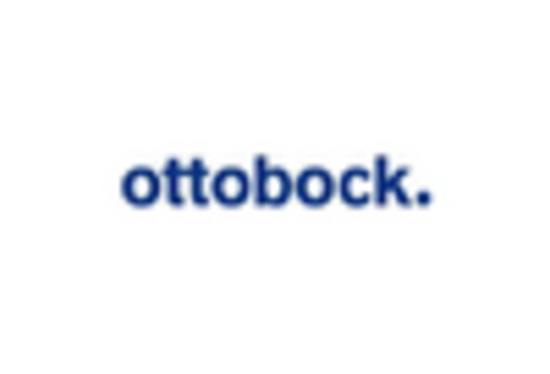North America : Market Leader in Innovation
North America is the largest market for off loading devices, accounting for approximately 45% of the global market share. The region's growth is driven by advanced healthcare infrastructure, increasing prevalence of orthopedic conditions, and a strong focus on research and development. Regulatory support from agencies like the FDA further catalyzes innovation and market expansion. The demand for off loading devices is also fueled by an aging population and rising healthcare expenditures. The United States is the leading country in this region, hosting major players such as Stryker, DePuy Synthes, and Zimmer Biomet. These companies are at the forefront of technological advancements, offering a wide range of products tailored to meet diverse patient needs. Canada also plays a significant role, contributing to the competitive landscape with its growing healthcare sector and increasing adoption of advanced medical technologies. Overall, the presence of key players and robust healthcare policies solidify North America's market position.
Europe : Emerging Market with Growth Potential
Europe is witnessing significant growth in the off loading device market, holding approximately 30% of the global share. The region benefits from a well-established healthcare system, increasing awareness of orthopedic treatments, and supportive regulatory frameworks. Countries like Germany and the UK are leading this growth, driven by rising incidences of musculoskeletal disorders and an aging population. The European Medicines Agency (EMA) plays a crucial role in ensuring product safety and efficacy, which further boosts market confidence. Germany stands out as the largest market in Europe, with a strong presence of key players such as Ottobock and Smith & Nephew. The UK follows closely, with a growing demand for innovative off loading solutions. The competitive landscape is characterized by collaborations and partnerships among manufacturers to enhance product offerings. Additionally, the increasing focus on minimally invasive procedures is expected to drive further growth in the region, making Europe a key player in the off loading device market.
Asia-Pacific : Rapid Growth and Adoption
Asia-Pacific is emerging as a significant player in the off loading device market, accounting for approximately 20% of the global share. The region's growth is propelled by increasing healthcare investments, a rising population, and a growing prevalence of orthopedic conditions. Countries like China and India are witnessing rapid adoption of advanced medical technologies, supported by government initiatives aimed at improving healthcare access and quality. The regulatory environment is evolving, with agencies working to streamline approval processes for new devices. China is the largest market in the region, driven by a booming healthcare sector and increasing demand for orthopedic solutions. India follows closely, with a growing middle class and rising healthcare expenditures. The competitive landscape is marked by the entry of both local and international players, including Apex Medical and Medtronic. As the region continues to develop, the off loading device market is expected to expand significantly, driven by innovation and increased healthcare access.
Middle East and Africa : Untapped Potential and Growth
The Middle East and Africa region is gradually emerging in the off loading device market, holding approximately 5% of the global share. The growth is primarily driven by increasing healthcare investments, rising awareness of orthopedic treatments, and a growing population. Countries like South Africa and the UAE are leading this growth, supported by government initiatives aimed at enhancing healthcare infrastructure. The regulatory landscape is improving, with efforts to standardize medical device approvals, which is crucial for market expansion. South Africa is the largest market in this region, with a growing demand for advanced medical technologies. The UAE is also witnessing significant growth, driven by a focus on healthcare innovation and quality. The competitive landscape is characterized by the presence of both local and international players, with companies like Hanger making strides in the market. As the region continues to develop, the off loading device market is expected to see substantial growth, driven by increased healthcare access and investment.


















Leave a Comment